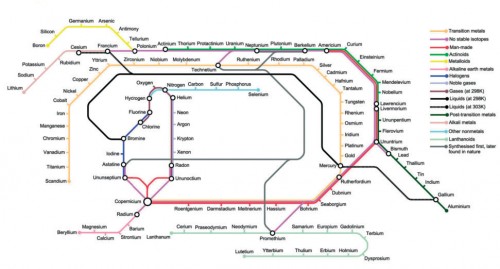Help students really get to grips with the Periodic Table, using Dr Catherine Smith’s imaginative activities…
Help students really get to grips with the Periodic Table, using Dr Catherine Smith’s imaginative activities…
Today you will…
- Gain an understanding of the way the elements are arranged in the periodic table
- Model the way scientists work, during your investigations into the chemistry and properties of elements in the same group in the periodic table
At some stage, every chemistry student momentarily loses his or her focus and ends up staring at the Periodic Table, hung in school chemistry laboratories across the world. These often feature the man best known for its discovery, Dmitri Mendeleev, pictured with his long grey hair and impressive beard. In this lesson and supporting activities, the students will discover the way in which Mendeleev organised the elements known at the time, into a meaningful and predictive Periodic Table, and begin to realise the fundamental nature to all chemistry of the Table he produced.
Starter activity
The students’ interest can be captured from the minute they walk through the door by playing either Tom Lehrer’s The Elements [AR1] or the more recent ‘in order’ version produced by AsapSCIENCE [AR2]. To stimulate discussion and see how much the students already know about the Periodic Table, students can be shown the Underground Map of the Elements recently produced by Mark Lorch [AR3] but with the key blanked out. Students may recognise the arrangement of atoms in the same row (group) as lying on one line, or be able to identify elements on the black line as all being liquids at room temperature.
Key resource
Looking for a large periodic table poster for your classroom? the royal society of chemistry’s colourful visual elements periodic table wall charts are a0 in size and help bring the periodic table to life using murray robertson’s stunning visual elements artwork.
The wall chart costs £9.95 (rsc members get 35% off) and can be pre-ordered by emailing education@rsc.org with ‘wallchart’ in the subject line.
Main activities
Inquiry based activity
In this fully resourced activity, the students are required to model the way in which Mendeleev worked to arrange the elements into the order they are now found in the Periodic Table.
Step 1:
Using the fact cards for the known elements from [AR4] the students are initially asked to identify how many different ways they can group the elements. This encourages the students to look in detail at the information given on each card, and may stimulate some good questions linked to the meaning of density, the difference between reacting with water and simply dissolving etc
Step 2:
The students are now required to arrange the elements as they are found on the current Periodic Table. By undergoing this process, the students begin to recognise its grid-like layout. The importance of leaving gaps when elements are missing becomes important.
Step 3:
With the arrangement of elements and gaps in front of them, the students must now identify similarities and trends between elements in the same group. Sharing of ideas between student groups allows for a wider array of similarities and trends to be identified, and enables the students to build upon each others’ ideas and hence develop their own understanding further i.e. effectively model good scientific practice.
Step 4:
The students now need to look at the properties of each of the unknowns (numbered 1-9) and use these properties, together with the similarities and trends they identified in Step 3, to identify the location of each of the unknowns in the Periodic Table and hence determine their identity.
An extension task can be for students to predict the properties for an element not on their cards and then use a data book or [AR5] to see if their predictions are correct.
Student research
The Visual Elements Periodic Table produced by the Royal Society of Chemistry is an excellent resource to enable the students to carry out individual research into one particular element in a group, and then combine their results to identify similarities and trends between elements in the same group.

In groups, students are individually allocated an element from one particular group in the Periodic Table to research. Using the interactive features on the Visual Elements Periodic Table, the students can find out facts about their element such as its appearance, if it is a metal or a non-metal, its melting point, atomic radius etc. The podcasts hosted by Chemistry World and the videos produced by the University of Nottingham linked in [AR5] to each element, allow the students to learn about the reactivity of the element in an engaging way. Once each student has completed their individual research, they then rejoin their group members and arrange the elements in the order they are in the Periodic Table. This works especially well if the students create cards for their individual elements which can then be linked by treasury tags into a hanging column as they are found in the Periodic Table. By identifying similarities and trends between the elements in their group, the students are going through the same thought processes as Dmitri Mendeleev himself. If any member of the group fails to complete the research, the information is simply missing; the students must leave a gap for a yet undiscovered element.
Summary
There are many excellent resources available for assessing the students’ understanding of this topic in a fun and interactive way. To show progress a simple activity would be to show the students the Underground Map of the Elements from the Starter Activity again and ask them to identify further links between elements.
If the students have studied atomic structure prior to this lesson, an excellent mind-mapping activity that assesses their understanding of the learning from this lesson and links it to their understanding of atomic structure, can be found in ‘Revising the Periodic Table’ from the RSC’s Chemical Misconceptions series [AR6].
For a fun end to the lesson, the quiz produced by APBI [AR7] is excellent and allows either for students to individually assess their own understanding, or for whole class assessment with the use of individual student whiteboards. The level can be set to allow for differentiation, with the students needing to identify the position of the element in the Periodic Table knowing; i. its name, symbol and properties; ii. its symbol and properties or; iii. its properties only.
Stretch them further
In the royal society of chemistry’s visual elements periodic table [ar5], each element is provided with a visual representation aimed to produce a vibrant representation of the element, not simply by giving an image of the element’s physical appearance but also by investigating the manner in which the element affects our daily lives. the students could be set the considerable challenge of researching one specific element and creating a new image to represent it.
Additional resources
About the expert
Dr Catherine Smith is an Advanced Skills Teacher in Science at John Cleveland College in Hinckley, Leicestershire. For the academic year 2011-2012, she was an Royal Society of Chemistry School Teacher Fellow based at the University of Leicester funded through the National HE STEM programme.










Help students really get to grips with the Periodic Table, using Dr Catherine Smith’s imaginative activities…